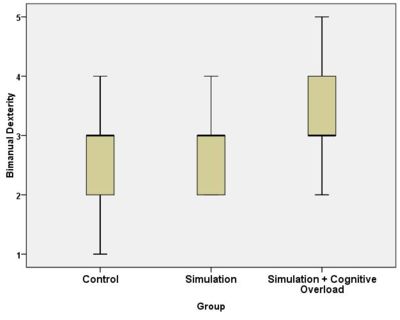C1 - 10: TRAINING WITH COGNITIVE OVERLOAD IMPROVES PERFORMANCE UNDER SIMILAR CONDITIONS IN A REAL SURGICAL TASK
Ganesh Sankaranarayanan, PhD1, Coleman Odlozil1, Katerina O Wells, MD, MPH1, Steven G Leeds, MD1, Sanket Chauhan, MD1, James W Fleshman, MD1, Daniel B Jones, MD2, Suvranu De, ScD3; 1Baylor University Medical Center, 2Beth Israel Deaconess Medical Ccenter, 3Rensselaer Polytechnic Institute
BACKGROUND: Cognitive overload affects surgical performance, but little is understood on whether repeated training under this condition can benefit actual procedures performed in an operating room. In this work, the effect of training under cognitive load is tested on a surgical task using VBlaST©, a virtual reality simulator for training and running a small bowel using a pig intestine as a transfer procedure. Two-digit math multiplication questions were used to induce cognitive overload.
METHOD: 11 medical students were randomly assigned to three groups, control (CG), simulation (SM) and simulation with cognitive overload (SM+CL). Both SM and SM+CL groups repeated the peg transfer task for 5 days a week for three weeks (total 150 trials). A Generalized Estimating Equation (GEE) on the normalized score was used to assess the learning curves. Two weeks after training, all three groups performed the transfer task on a pig intestine set up in a box and pre-marked every 10 cm on the antimesenteric portion for 150 cm while under cognitive overload. Performance was videotaped and rated using modified GOALS by two experts that assessed 6 metrics. Cronbach’s alpha and Interclass Correlation Coefficient were computed to assess the inter-rater reliability. Kruskull-Wallis test was used to find significance among the groups. Mann Whitney U test was used to perform post hoc comparisons.
RESULTS AND CONCLUSION: The GEE analysis showed that the learning curves increased with trials to a mean value of 87.74 for SM and 80.85 for SM+CL group and were significant (β = 7.741, 95% CI [0.002 – 15.48], p = 0.05). The rating scores showed high reliability (Cronbach’s Alpha = 0.818) and inter-rater agreement (ICC = 0.748, p < 0.0001). Significance among groups were found for bimanual dexterity (BD) (p = 0.042) and time and motion (TM) (p = 0.034). Post hoc comparison showed SM+CL group outperformed CG and SM group in BD (SM+CL vs SM, p = 0.016, SM+CL vs CG, p = 0.03) and better than SM group on TM (SM+CL vs SM, p = 0.005).
Training under cognitive overload benefitted performance on an actual surgical task under similar conditions.

